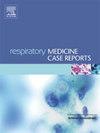Efficacy and safety of lenvatinib in a case of thymic carcinoma complicated with interstitial lung disease and anti-melanoma differentiation-associated gene 5 antibody-positive dermatomyositis: A case report
IF 0.7
Q4 RESPIRATORY SYSTEM
引用次数: 0
Abstract
Based on the results of a multicenter phase II study of patients with previously treated thymic carcinoma, lenvatinib administration for unresectable thymic cancer has been covered under insurance in Japan since 2021. However, patients with interstitial lung disease (ILD) were excluded from that study; therefore, the efficacy and safety of lenvatinib in these patients remain unknown. Herein, we report the case of a woman in her 50s who was diagnosed with thymic carcinoma complicated with ILD. In August 2016, the patient developed ILD with anti-melanoma differentiation-associated gene 5 (MDA5) antibody-positive dermatomyositis (DM). She received triple therapy comprising prednisolone, tacrolimus and azathioprine. In October 2021, the patient complained of lateral chest pain and back pain. In January 2022, computed tomography (CT) revealed an anterior mediastinal tumor, and percutaneous biopsy resulted in a diagnosis of thymic carcinoma with Masaoka classification IVb. In March 2022, first-line treatment with four cycles of carboplatin (area under the curve, 6) + paclitaxel (200 mg/m2) was initiated. Although a partial response was achieved, in September 2022, CT demonstrated progressive disease (PD). Therefore, in October 2022, Lenvatinib (24 mg) was started as the second-line treatment. The best response was stable disease; moreover, although lenvatinib dose reduction was required owing to adverse events, such as biliary-tract infection and stomatitis. The patient did not experience ILD exacerbation. Lenvatinib (14 mg) was continued until PD was observed in March 2023. Our findings suggest that lenvatinib is a viable treatment option for thymic carcinoma with ILD.
lenvatinib治疗胸腺癌合并间质性肺疾病和抗黑色素瘤分化相关基因5抗体阳性皮肌炎1例的疗效和安全性
根据一项针对既往治疗过的胸腺癌患者的多中心II期研究结果,自2021年以来,lenvatinib治疗不可切除的胸腺癌已纳入日本保险范围。然而,间质性肺疾病(ILD)患者被排除在该研究之外;因此,lenvatinib在这些患者中的有效性和安全性仍然未知。在此,我们报告一位50多岁的女性被诊断为胸腺癌合并ILD的病例。2016年8月,患者发展为ILD并伴有抗黑色素瘤分化相关基因5 (MDA5)抗体阳性的皮肌炎(DM)。她接受了强的松龙、他克莫司和硫唑嘌呤的三联治疗。2021年10月,患者主诉侧胸痛和背部疼痛。2022年1月,CT显示前纵隔肿瘤,经皮活检诊断为胸腺癌,Masaoka分型IVb。2022年3月,开始一线治疗,卡铂(曲线下面积6)+紫杉醇(200 mg/m2) 4个周期。虽然取得了部分缓解,但在2022年9月,CT显示疾病进展(PD)。因此,在2022年10月,Lenvatinib (24mg)开始作为二线治疗。最佳反应是病情稳定;此外,尽管由于胆道感染和口炎等不良事件需要减少lenvatinib剂量。患者未经历ILD恶化。Lenvatinib (14mg)继续使用,直到2023年3月观察到PD。我们的研究结果表明lenvatinib是胸腺癌合并ILD的可行治疗选择。
本文章由计算机程序翻译,如有差异,请以英文原文为准。
求助全文
约1分钟内获得全文
求助全文
来源期刊

Respiratory Medicine Case Reports
RESPIRATORY SYSTEM-
CiteScore
2.10
自引率
0.00%
发文量
213
审稿时长
87 days
 求助内容:
求助内容: 应助结果提醒方式:
应助结果提醒方式:


